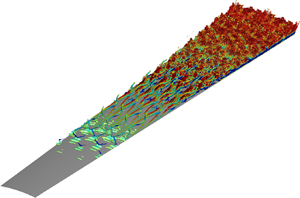Crossref Citations
This article has been cited by the following publications. This list is generated based on data provided by
Crossref.
Hartman, Andrew
Hader, Christoph
and
Fasel, Hermann F.
2021.
Direct Numerical Simulations of laminar-turbulent boundary-layer transition for blunt cones at Mach 6: Effect of Varying Nose Bluntness.
Hader, Christoph
and
Fasel, Hermann F.
2021.
Direct Numerical Simulations of Hypersonic Boundary-Layer Transition for a Straight Cone at Mach 4: Oblique Breakdown.
Melander, Luke J.
Dwivedi, Anubhav
and
Candler, Graham V.
2022.
Numerical Investigation of Nosetip Bluntness Effects on Cone Frustum Boundary Layer Transition in Hypersonic Flow.
Goparaju, Hemanth
and
Gaitonde, Datta V.
2022.
Role of entropic instabilities in laminar-turbulent transition on a blunted flat plate.
Physical Review Fluids,
Vol. 7,
Issue. 10,
Scholten, Anton
Paredes, Pedro
Luke Hill, J.
Borg, Matthew
Jewell, Joseph S.
and
Choudhari, Meelan M.
2022.
Linear Instabilities over Ogive-Cylinder Models at Mach 6.
AIAA Journal,
Vol. 60,
Issue. 8,
p.
4478.
Meersman, John A.
Hader, Christoph
and
Fasel, Hermann F.
2022.
Numerical Investigation of Hypersonic Boundary-Layer Transition for an Ogive Cone.
Zhou, Teng
Liu, Zaijie
Lu, Yuhan
Wang, Ying
and
Yan, Chao
2022.
Direct numerical simulation of complete transition to turbulence via first- and second-mode oblique breakdown at a high-speed boundary layer.
Physics of Fluids,
Vol. 34,
Issue. 7,
Tsakagiannis, Vasilis
Hader, Christoph
and
Fasel, Hermann F.
2022.
Nonlinear wave packet simulation for a cone at Mach 10 using a GPU accelerated pseudo-spectral scheme.
Liu, Meikuan
Han, Guilai
Li, Zongxian
and
Jiang, Zonglin
2022.
Experimental study on the effects of the cone nose-tip bluntness.
Physics of Fluids,
Vol. 34,
Issue. 10,
Guo, Peixu
Shi, Fangcheng
Gao, Zhenxun
Jiang, Chongwen
Lee, Chun-Hian
and
Wen, Chihyung
2022.
Heat transfer and behavior of the Reynolds stress in Mach 6 boundary layer transition induced by first-mode oblique waves.
Physics of Fluids,
Vol. 34,
Issue. 10,
Zhang, Chuanhong
and
Shi, Zhiwei
2022.
Nonlinear wave interactions in a transitional hypersonic boundary layer.
Physics of Fluids,
Vol. 34,
Issue. 11,
Zhu, Yiding
Zhu, Wenkai
Gu, Dingwei
Lee, Cunbiao
and
Smith, Charles R.
2022.
Transitional flow structures in heated hypersonic boundary layers.
Physics of Fluids,
Vol. 34,
Issue. 5,
Zhao, Lei
He, Jianhong
and
Dong, Ming
2023.
Asymptotic theory of Mack-mode receptivity in hypersonic boundary layers due to interaction of a heating/cooling source and a freestream sound wave.
Journal of Fluid Mechanics,
Vol. 963,
Issue. ,
Zhu, Yanhua
Li, Xinliang
Guo, Tongbiao
Liu, Hongwei
and
Tong, Fulin
2023.
Direct numerical simulation of slender cones with variable nose bluntness based on graphics processing unit computation.
Physics of Fluids,
Vol. 35,
Issue. 7,
ZHOU, Teng
LU, Yuhan
and
YAN, Chao
2023.
Investigation of influence of local cooling/heating on nonlinear instability of high-speed boundary layer with direct numerical simulations.
Chinese Journal of Aeronautics,
Vol. 36,
Issue. 12,
p.
77.
Guo, Peixu
Hao, Jiaao
and
Wen, Chih-Yung
2023.
Interaction and breakdown induced by multiple optimal disturbances in hypersonic boundary layer.
Journal of Fluid Mechanics,
Vol. 974,
Issue. ,
Zhuang, Guo-Hui
Wan, Zhen-Hua
Ye, Chuang-Chao
Luo, Zhen-Bing
Liu, Nan-Sheng
Sun, De-Jun
and
Lu, Xi-Yun
2023.
Active transition control by synthetic jets in a hypersonic boundary layer.
Physics of Fluids,
Vol. 35,
Issue. 3,
Chen, Xi
Dong, Siwei
Tu, Guohua
Yuan, Xianxu
and
Chen, Jianqiang
2023.
Global stability analyses of Mack mode on the windward face of a hypersonic yawed cone.
Physical Review Fluids,
Vol. 8,
Issue. 3,
Song, Runjie
Dong, Ming
and
Zhao, Lei
2023.
Effect of cone rotation on the nonlinear evolution of Mack modes in supersonic boundary layers.
Journal of Fluid Mechanics,
Vol. 971,
Issue. ,
Paredes, Pedro
Scholten, Anton
Choudhari, Meelan M.
and
Li, Fei
2023.
Modal Instabilities over Blunted Cones at Angle of Attack in Hypersonic Flow.
Journal of Spacecraft and Rockets,
Vol. 60,
Issue. 4,
p.
1188.

 $7^\circ$ half-angle) at Mach 5.9 and zero angle of attack. First, (linear) stability calculations were carried out by employing a high-order Navier–Stokes solver and using very small disturbance amplitudes in order to capture the linear disturbance development. Contrary to standard linear stability theory (LST) results, these investigations revealed a strong ‘linear’ instability in the entropy-layer region for a very short downstream distance for oblique disturbance waves with spatial growth rates far exceeding those of second-mode disturbances. This linear instability behaviour was not captured with conventional LST and/or the parabolized stability equations (PSE). Secondly, a nonlinear breakdown simulation was performed using high-fidelity DNS. The DNS results showed that linearly unstable oblique disturbance waves, when excited with large enough amplitudes, lead to a rapid breakdown and complete laminar-turbulent transition in the entropy layer just upstream of the second-mode instability region.
$7^\circ$ half-angle) at Mach 5.9 and zero angle of attack. First, (linear) stability calculations were carried out by employing a high-order Navier–Stokes solver and using very small disturbance amplitudes in order to capture the linear disturbance development. Contrary to standard linear stability theory (LST) results, these investigations revealed a strong ‘linear’ instability in the entropy-layer region for a very short downstream distance for oblique disturbance waves with spatial growth rates far exceeding those of second-mode disturbances. This linear instability behaviour was not captured with conventional LST and/or the parabolized stability equations (PSE). Secondly, a nonlinear breakdown simulation was performed using high-fidelity DNS. The DNS results showed that linearly unstable oblique disturbance waves, when excited with large enough amplitudes, lead to a rapid breakdown and complete laminar-turbulent transition in the entropy layer just upstream of the second-mode instability region.


